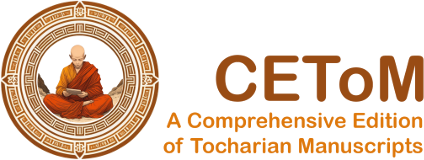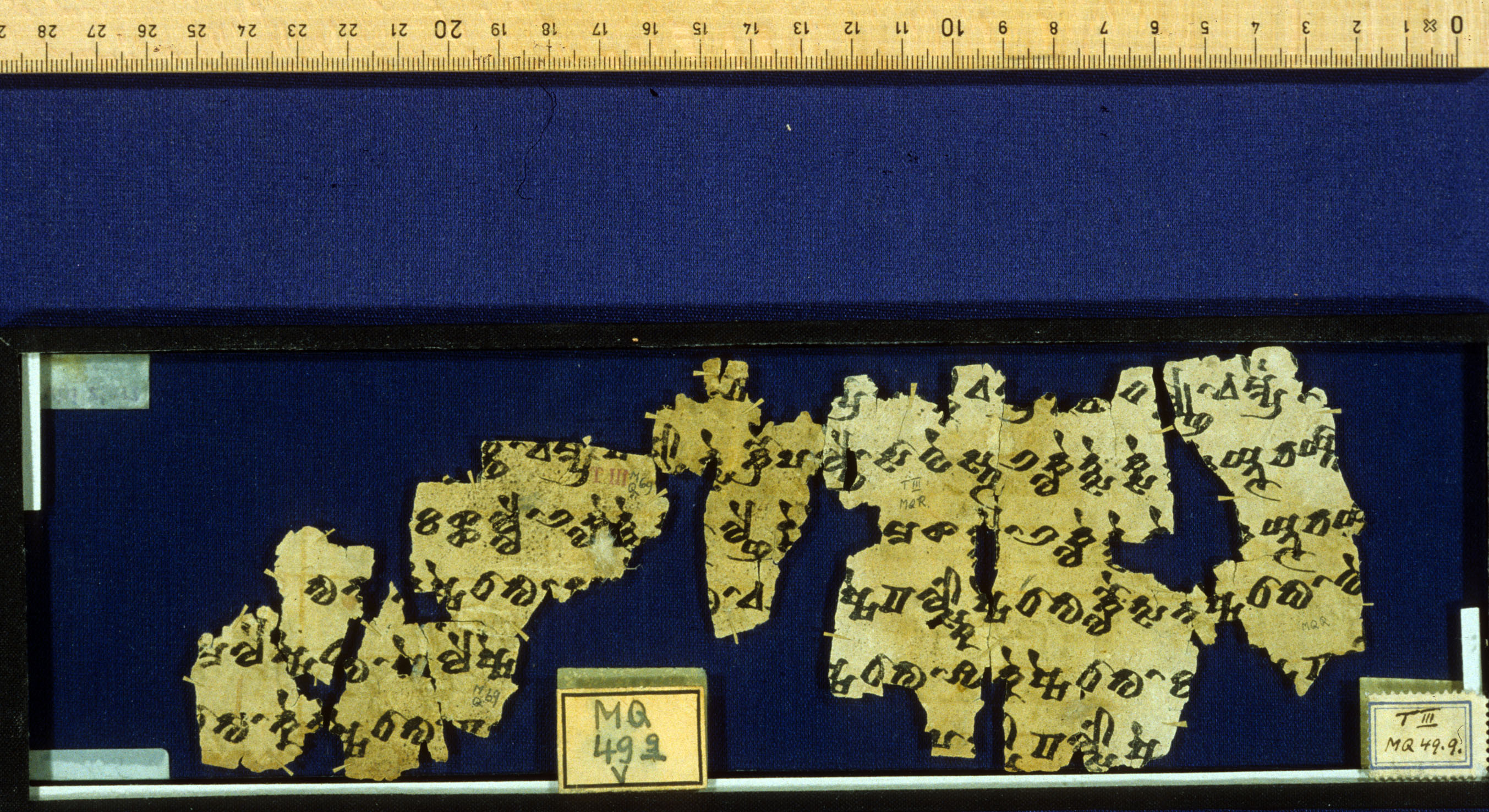THT 155
| Known as: | THT 155; B 155; Bleistiftnummer 2483 |
|---|---|
| Cite this page as: | "THT 155". In A Comprehensive Edition of Tocharian Manuscripts (CEToM). Created and maintained by Melanie Malzahn, Martin Braun, Hannes A. Fellner, and Bernhard Koller. https://cetom.univie.ac.at/?m-tht155 (accessed 12 Jul. 2025). |
Provenience | |
| Main find spot: | Kizil Ming-öy |
| Expedition code: | T III MQ 49.9 |
| Collection: | Berlin Turfan Collection |
Language and Script | |
| Language: | TB |
| Linguistic stage: | classical |
| Script: | classical |
Text contents | |
| Title of the work: | Pratītyasamutpāda |
| Text genre: | Literary |
| Text subgenre: | Abhidharma |
| Verse/Prose: | prose |
Object | |
| Manuscript: | Pratītyasamutpāda α |
| Material: | ink on paper |
| Form: | Poṭhī |
| Number of lines: | 6 |
Images
Images from idp.bl.uk by courtesy of the International Dunhuang Project, the Berlin-Brandenburgische Akademie der Wissenschaften, and the Staatsbibliothek zu Berlin – Orientabteilung.
Transliteration
| a1 | /// [t]ū pa – – – – [m]pr· [pi] [l]k[o] e mpr· [k]· śa ta – lyñe • e mpreṃ [re] /// |
|---|---|
| a2 | /// [ñ]ñ· • e mpr· [pa] l[sk]o ntse krau pa lñe • sā we stra la kle ntse kse – [ne] ynū ca ytā /// |
| a3 | /// ka s̝s̝a lle • la kle ntse – – lñe re ·[e] – ma s̝a lle • la kle ntse ·e – [ne] ynū ca y[t]ā /// |
| a4 | /// tu n[ma] – – – – – [ne] ṣṣe dhā tu • r· – – – [tu] • e [śa] – ṣṣe pa lsko ṣṣe dhā tu – klau tsa n[e] ṣṣe dhā tu • we /// |
| a5 | /// m[e] le· ṣṣe dh· – – – – – – tu • me leṃ ṣṣe – – – – – – – – ṣṣ· dhā tu • śu ke ṣṣe dhā tu • ka – [ṣṣe] pa [l]·[o] /// |
| a6 | /// [dh]ā tu • ke [k]·[e] – – – – ṣṣe dhā tu • pa – – – – – – – – – – – – pa ls[k]o pa ls·o ṣ[ṣ]e /// |
| b1 | /// śtwā ra • [la] [kle] – – – – tsa ññe • [la]· [l]· – – – – – – – – [p]ru [tkā] lyñ·¯ ¯ś ynū /// |
| b2 | /// ma ksu ste [ta] – – – – – • ktsai t[sa] ññe la – – – – – – – – – [l]yñ· [la] kl· • la r· nmeṃ tsre lle wä – – [la] /// |
| b3 | /// ña – – – – – (–) [lñe] la kle • au lts· – – – – (–) [p]· ś· – – – kle • se we stra la kle klyo moṃ¯ ¯ts [e] mpr[e]ṃ tsa ññe /// |
| b4 | /// [l]ñ· ṣṣa ka tkau ñai yā s· – ṣ· sa ynū – o¯ ¯mp o¯ ¯mp ca me lne ·i – ·e ñcca se we /// |
| b5 | /// [ñ]·e ma ksu ste • ta – [k]a yo kai ntse na no cme lñe ṣṣai ka tkau wñai [y]· – mpa ṣe sa /// |
| b6 | /// p· tkā l·e [n]e rvāṃ kse lñe • se we st· la [kle]· s· pru tkā lñe /// |
Transcription
| a1 | /// tū pä(klyauṣ) (•) (e)mpr(eṃ) pilko empr(eṃ) k(e)ś{†ä} tä(ttā)lyñe • empreṃ re /// |
|---|---|
| a2 | /// ññ(e) • empr(eṃ) pälskontse kraupalñe • sā westrä läklentse kse(lñe)ne ynūca ytā /// |
| a3 | /// käṣṣälle • läklentse (prutkā)lñe re(m)e (ya)maṣälle • läklentse (ks)e(lñe)ne ynūca ytā /// |
| a4 | /// tunma – – – – – neṣṣe dhātu • r(upaṣṣe) (dhā)tu • eśa(ne)ṣṣe pälskoṣṣe dhātu (•) klautsaneṣṣe dhātu • we /// |
| a5 | /// mele(ṃ)ṣṣe dh(ātu) (•) (wereṣṣe) (dhā)tu • meleṃṣṣe (pälskoṣṣe) (dhātu) (•) (käntwā)ṣṣ(e) dhātu • śukeṣṣe dhātu • kä(ntwā)ṣṣe päl(sk)o /// |
| a6 | /// dhātu • kek(ts)e(ñäṣṣe) (pälsko)ṣṣe dhātu • pä(lskoṣṣe) (dhātu) (•) (pelaikneṣṣe) (dhātu) (•) palsko päls(k)oṣṣe /// |
| b1 | /// śtwāra • lakle – – – – tsäññe • lä(k)l(entse) (prutkālñe) (•) (läklentse) prutkālyñ(e)ś ynū /// |
| b2 | /// mäksu ste tä – – – – – • ktsaitsäññe la(kle) (•) (teki) (lakle) (•) (sruka)lyñ(e) lakl(e) • lar(e)nmeṃ tsrelle wä – – la /// |
| b3 | /// ña – – – – – – lñe lakle • aults· – – – – – p· ś· – – – kle • se westrä lakle klyomoṃts empreṃtsäññe /// |
| b4 | /// lñ(e)ṣṣa katkauñai yās· – ṣ(e)sa ynū(ca) omp omp camelne ·i – ·eñcca se we /// |
| b5 | /// ñ·e mäksu ste • ta – k{†ä} yokaintse nano cmelñeṣṣai katkauwñai y(āso)mpa ṣesa /// |
| b6 | /// p(ru)tkāl(ñ)e nervāṃ kselñe • se west(rä) läkle(nt)s(e) prutkālñe /// |
Other
| a2 | Dies wird der zum Erlöschen des Leides führende Weg genannt. (Schmidt 1974: 225) |
|---|
Commentary
Remarks
| On IDP, recto and verso are reversed. |
Alternative linguistic/paleographic classifications
| Tamai 2011 | C2 |
| Tamai 2011 | C14 |
References
Online access
other
Sieg and Siegling 1953: 84-85; Carling 2000: 247; Schmidt 1974: 225; Carling 2000: 247; Carling 2000: 243; Thomas 1986: 145
Translations
Schmidt 1974: a2 (225)
Bibliography
Carling, Gerd. 2000. Die Funktion der lokalen Kasus im Tocharischen. Berlin/New York: de Gruyter.
“The International Dunhuang Project: The Silk Road Online.” n.d. http://idp.bl.uk.
Schmidt, Klaus T. 1974. “Die Gebrauchsweisen des Mediums im Tocharischen.” PhD, Universität Göttingen.
Sieg, Emil, and Wilhelm Siegling. 1953. Tocharische Sprachreste. Sprache B, Heft 2. Fragmente Nr. 71-633. Edited by Werner Thomas. Göttingen: Vandenhoeck & Ruprecht.
Tamai, Tatsushi. 2011. Paläographische Untersuchungen zum B-Tocharischen. Innsbrucker Beiträge zur Sprachwissenschaft 138. Innsbruck: Institut für Sprachen und Literaturen.
Thomas, Werner. 1986. “Zur Stellung von toch. A nuṃ, B nano ‘wieder’ innerhalb des Satzes.” Zeitschrift für Vergleichende Sprachforschung 99: 117–46.
Gippert, Jost, Katharina Kupfer, Christiane Schaefer, and Tatsushi Tamai. n.d. “Thesaurus Indogermanischer Text- und Sprachmaterialien (TITUS): Tocharian Manuscripts from the Berlin Turfan Collection.” http://titus.fkidg1.uni-frankfurt.de/texte/tocharic/thtframe.htm.




